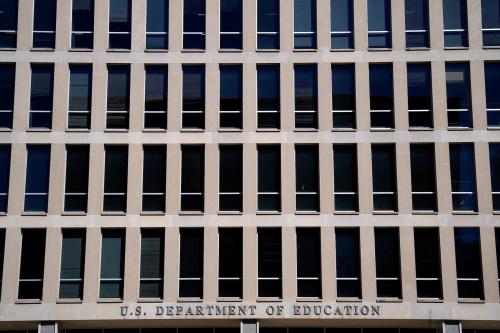This is part of the “Why we have and need a US Department of Education” series, which seeks to examine the role of the U.S. Department of Education at a time when the president of the United States has called for the Department’s demise. It considers what the Department does to shape education policy and practice in the United States. It also addresses misconceptions about the Department’s role and the president’s authority to dismantle it.
On February 14, 2025, the U.S. Department of Education’s Office for Civil Rights (OCR) released non-binding guidance in the form of a Dear Colleague Letter (DCL) ostensibly aimed at clarifying schools’ and colleges’ obligations under Title VI of the 1964 Civil Rights Act. Title VI prohibits federally funded programs from discriminating on the basis of race, ethnicity, national origin, or shared ancestry. The guidance letter also invoked the U.S. Supreme Court’s 2023 Students for Fair Admissions v. Harvard (SFFA) decision, which banned the use of race-based affirmative action in college admissions as further motivation for clarifying institutional requirements under Title VI. The guidance letter goes on to claim that any race-conscious efforts or initiatives, including diversity, equity, and inclusion (DEI) programs, are in violation of federal civil rights law, giving institutions 14 days to comply.
Here’s the kicker. Despite the acting assistant secretary’s claim that the DCL “reiterates existing legal requirements under Title VI, the Equal Protection Clause…and other relevant authorities,” it goes far beyond the law. The DCL proposes a more expansive definition of what constitutes illegal racial discrimination than what is required by the Title VI regulations (which dictate OCR’s enforcement work), or what is implied by the recent SFFA decision. And importantly, dramatically expanding how federal law defines discrimination is not something an assistant secretary of civil rights (nor the secretary of education) has the legal authority to do.
In this post, I provide a brief overview of OCR’s long-running operational definition of racial discrimination under the Title VI regulations and what the SFFA decision says, summarize why this DCL represents an overreach of OCR’s authority, and detail what school and district leaders and higher education administrators might expect after the DCL’s February 28 deadline expires.
How racial discrimination is defined under Title VI
OCR primarily enforces Title VI by investigating complaints of civil rights abuses submitted to the agency by families and advocates. Those activities are guided by the department’s Title VI regulations, which define what constitutes racial discrimination under the law.
The Title VI regulations define discrimination using two legal frameworks: disparate treatment (or intentional discrimination) and disparate impact (discriminatory effects, regardless of intent). Establishing disparate treatment typically requires proof of discriminatory intent using either direct or circumstantial evidence. Direct evidence of discriminatory intent (e.g., school policies written in expressly discriminatory ways) is typically rare. Circumstantial evidence demonstrating that the most plausible explanation is discrimination is far more common. For example, OCR investigators may use student discipline records to show that similarly situated students of different races are punished differently for the same first-time offense (e.g., disrupting class) as circumstantial evidence.
In comparison, discrimination can occur under disparate impact when a facially neutral policy or practice has a discriminatory effect on a racial or ethnic group of students, regardless of whether the policies or practices were intended to be discriminatory. To show evidence of disparate impact, OCR must implement a three-part test aimed at determining whether the policy or practice under question is at all justifiable. (For additional details on the Title VI regulations and examples of Title VI investigations, see this primer from the Education Rights Institute at the University of Virginia.)
In 2014, the Obama administration issued a DCL on avoiding racial discrimination in the application of school discipline that emphasized both disparate treatment and disparate impact discrimination. The administration’s emphasis on disparate impact discrimination garnered significant criticism from conservative groups and accusations of federal overreach. Notably, though, the DCL described the existing Title VI regulations, which have been largely unchanged since 1980 (with revisions last adopted in 2000).
The important point here is that the Title VI regulations that define OCR’s enforcement work remain the same, regardless of whatever non-binding guidance the Trump administration has released.
The Trump DCL misrepresents schools’ and colleges’ obligations under Title VI
The February 14 DCL claims to reiterate institutions’ obligations under Title VI by clarifying the implications of the 2023 SFFA decision for Title VI enforcement. But it goes on to misrepresent the SFFA decision and what it means for institutions that receive federal funding. Despite the Court’s clarity that the SFFA decision relates only to the use of race in college admissions decisions, the letter falsely asserts that the “Supreme Court’s holding applies more broadly”—claiming that it prohibits consideration of race in “hiring, promotion, compensation, financial aid, scholarships, prizes, administrative support, discipline, housing, graduation ceremonies, and all other aspects of student, academic, and campus life.” This is plainly untrue. According to Dr. Liliana Garces, an education and legal scholar, this amounts to “OCR… effectively demanding new obligations of institutions without the proper legal authority to do so.”
The DCL goes on to provide a number of examples—broad and specific—that contradict the 2023 SFFA decision and federal court decisions made within the last year:
- The DCL warns that DEI programs discriminate by “deny[ing] students the ability to participate fully in the life of a school.” Yet, a group of legal scholars make clear that that SFFA “does not render DEI initiatives legally suspect,” and only has potential legal implications for policies or practices that explicitly rely on “racial classifications” to withhold or bestow benefits or punishments.
- The DCL’s assertion that schools are prohibited from using student essays “as a means of determining or predicting a student’s race and favoring or disfavoring students” directly contradicts the Court’s majority ruling that colleges can still consider “applicant’s discussion of how race affected his or her life, be it through discrimination, inspiration, or otherwise.”
- The DCL claims that “it would… be unlawful for an educational institution to eliminate standardized testing to achieve a desired racial balance or to increase racial diversity.” Yet, recent federal court rulings in Boston Parent Coalition for Academic Excellence v. School Committee of the City of Boston and Coalition for TJ v. Fairfax County School Board say otherwise. Both decisions held that equity-motivated, race-neutral changes to school admissions policies were legal (with the Supreme Court declining to weigh in on both cases).
All in all, the February 14 DCL represents a blatant overreach of executive authority and an attempt to rewrite Title VI to undermine any state or local efforts to promote racial equity.
What schools and colleges might expect after the February 28 deadline
The February 14 DCL gives PK-12 and higher education institutions 14 days (until February 28, 2025) to comply with the directives of the guidance. It threatens to withhold federal funding from institutions that fail to comply.
Whether that’s a credible threat—and to what extent—remains unclear.
There are several reasons to be skeptical that robust OCR enforcement will arrive on March 1. First, OCR is a small, underfunded agency with limited capacity, and it seems unlikely to grow amid staffing cuts at the U.S. Department of Education. This will undermine the agency’s ability to swiftly enforce an expanded interpretation of Title VI.
Second, OCR does not have insight into much of what goes on in districts and colleges across the nation (nor does the Department more broadly). This means that any enforcement efforts will be reactive—either to news reports or civil rights complaints the agency receives. As such, Trump’s OCR is unlikely to ever learn of the vast majority of race-conscious efforts and equity initiatives it seeks to limit.
Third, even if OCR found out about a school’s (or district’s or college’s) DEI program or other race-conscious activities, the agency would have to follow a lengthy series of steps (as detailed in the Title VI regulations)—and survive potential legal challenges—before it can terminate funding. This includes opening an investigation or compliance review and documenting available evidence, all while giving recipient institutions ample opportunities to negotiate a settlement. These processes are intended to afford institutions due process in navigating civil rights inquiries initiated by the federal government. Consequently, it is very rare that OCR actually terminates or rescinds an institution’s funding.
This administration has already demonstrated its willingness to engage in lawlessness. Though, it’s important to keep in mind that the likelihood that OCR’s actions will withstand legal scrutiny declines the more they don’t follow the rules. And trying to enforce non-binding guidance that deviates from the existing regulations and current interpretations of federal law is very much not following the rules.
All told, the Trump administration will face significant legal and administrative hurdles in attempting to weaponize OCR toward their ideological aims. The great irony here is that many of those hurdles were put in place by conservatives themselves. Starting with the Nixon administration, Republican administrations and conservative groups have spent decades weakening civil rights enforcement tools and narrowing legal definitions of racial discrimination. As a result, significantly expanding OCR’s authority to use a broader definition of discrimination than the law allows will be no easy challenge.
The Brookings Institution is committed to quality, independence, and impact.
We are supported by a diverse array of funders. In line with our values and policies, each Brookings publication represents the sole views of its author(s).









Commentary
The Trump administration’s unlawful attempt to redefine racial discrimination
February 24, 2025